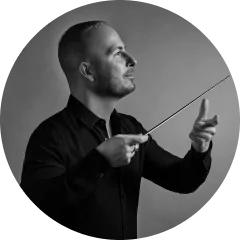When he started his first draft of Symphony No. 9 in D minor in the summer of 1887, Anton Bruckner was 63 years old. He had only recently achieved success as a composer after the premiere of his Symphony No. 7 three years earlier. But his final work was never finished—he died with a pen in his hand, nine years after writing the piece’s first notes.
The composer’s unconventional life began in 1824. Born in Austria into a family of schoolteachers, Anton was destined to follow in the footsteps of his father and grandfather. After receiving his first music lessons from his father, who also taught him the basics of the organ, he was sent to the Augustinian monastery in Sankt Florian to become a choirboy. Not only did he receive a quality musical education, but he also had the opportunity to play on the monastery’s prestigious great organ—which he would play again years later when he was appointed organist. While he didn’t delve into composition until a later age, he was largely self-taught, studying the works of Beethoven, Schubert, Mendelssohn, Liszt and of course, Wagner (see text box).
It wasn’t until he settled in Vienna in 1868 that Bruckner could start his career as a symphonic composer. He composed nine monumental symphonies that stand among the finest achievements of German Romanticism.
A deeply humble and modest man, Bruckner was misunderstood for most of his life. He was profoundly affected by the mockery and attacks from some Viennese critics, leading him to go so far as to rewrite his work, sometimes extensively. This explains why there are many versions of his symphonies available.
Unfinished
It took Bruckner seven years to write the first three movements of Symphony No. 9. A creature of habit, Bruckner wrote the first movement in sonata form* with three themes. Entitled “Feierlich, misterioso” (solemn, mysterious), the first movement opens with a slow and sombre introduction that slowly builds until the main theme bursts forth, played in unison by the entire orchestra. A second lyrical, soft and bright theme comes into contrast with the first idea. Lastly, a march-like progression leads into the development and, finally, the coda.
Considered by many experts to be the boldest symphonic movement composed by Bruckner, the Scherzo,* entitled “Bewegt, lebhaft” (moving, lively), is presented as an infernal dance. It is momentarily interrupted by the central trio, characterized by its fantastical quality and almost impressionistic colours.
The slow and solemn Adagio, one of the composer’s most inspired compositions, starts with Wagnerian harmonies reminiscent of Parisfal . Two ideas are explored: the first is like a slow march, then a hymn-like section called “Abschied vom Leben” (farewell to life). The work ends in a state of calm and contemplation, as though the musician’s soul is on its way to meet “the beloved God” to whom he dedicated his symphony and praised in all his music.
Crippled by illness, Bruckner suggested that his Te Deum be played as the finale to his symphony.

